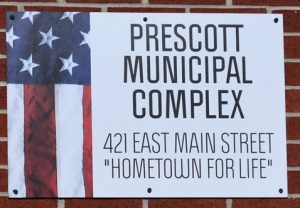Council discusses new zoning laws
By submitted, 03/21/23 11:03 AM
PRESCOTT – A zoning meeting was held prior to the regular monthly meeting of the Prescott City Council Monday night.
James Walden was on hand to discuss the changes and what they meant. First, Walden updated the maps for the city, which have been made digital for easier access and viewing. He also updated the city’s land use plan, making it comprehensive with strategies for future planning and zoning which should transition the city for the next 20-30 years – barring unforeseen circumstances. He informed the council there are two sets of regulations, one is the zoning codes while the other is for subdivision codes. The subdivision codes, he said, is more for site planning as it isn’t cost effective to develop subdivisions these days. The regulations, he continued, are only valid within the Prescott city limits.
Along with the planning and zoning commission, the city needs a board of adjustment. However, Walden said these can be the same people, but the board of adjustment must be treated as a separate entity as it has different powers and authorities along with having its own meetings. The planning and zoning committee has the option of adopting bylaws included in the plan or coming up with its own.
The biggest bone of contention dealt with mobile home and manufactured homes. Walden reminded the panel mobile homes are those made before 1976, while manufactured homes were build after 1976 and must meet federal standards. The plan details different zoning districts for the city. These are R1, low density residential; R2, medium density residential; R3, apartment residential; R1M, low density residential-manufactured; B1, buffer district; C1, downtown commercial; C2, general commercial; I1, general industrial; and A1, agricultural.
Manufactured homes, according to the plan can only be located in R1M zones and must meet certain criteria, including having to have a front door facing toward the street. This district encourages affordable housing of varied types in specified locations within the city and is characterized by site-built housing and manufactured homes placed on individual lots with uniform design guidelines imposed to maintain neighborhood harmony and consistency in appearance. In other words, no trashy mobile homes allowed. The manufactured homes must be new, have a warranty or pass an inspection before they can be moved onto property in the city limits. The plan spells out all the requirements required for manufactured homes.
Under the new plan, residents can no longer petition their potential neighbors for approval to place a manufactured home on a piece of property in a zone where manufactured homes aren’t allowed. However, manufactured homes can be placed on A1 lots.
The bulk of the zones are self-explanatory, though Walden did point out the council may want to refuse to allow any industry to locate within the city that might be hazardous, such as a fertilizer plant or a chemical manufacturing plant.
The other major issue the council was concerned with was scrap yards within the city limits. Those currently in existence will be grandfathered in, but they won’t be allowed to expand. The size they are is as large as they can be, and if the scrap yard is reduced in scope becoming smaller, it won’t be allowed to expand to its original size. Additionally, if it isn’t operational for 18 months, it can’t come back at all. Though nothing can be done about scrap yards under the zoning plan, Walden said it could be addressed as a code violation and addressed accordingly.
He recommended the city hire someone else to do building inspections as a different way of doing code enforcement. Or, he continued, a member of the Prescott Police Department could be utilized for the job, or the city could partner with another community. The most important thing, he said, is for the city to have a set bar and maintain it with code enforcement, working with people to get things done, but “bringing the hammer down” when enforcement is required regardless of who’s involved. He said a nuisance abatement board could be created and levy fines for violators, along with helping people find resources to correct problems they have. But the most important thing is to be consistent.
The question of cell tower locations was raised. Walden said these fall under the conditional use portion of the plan for residential areas, but they’re all right in commercial and industrial zones. Cell towers, he continued, need to be dealt with on a case-by-case basis as there could be legal issues involved.
He was also asked about solar panels. This wasn’t addressed in the new plan, though they do fall under the electric code requirements. Nothing about solar panels, Walden said, is written in stone and any of these zoning regulations can be repealed by the city council or changed as needed. The zoning plan is meant to adapt as the city changes.
Councilman Ivory Curry said the planning and zoning commission needs to be trained, adding he doesn’t want to be involved in zoning any more than necessary as a member of the council, adding the council doesn’t have time to deal with zoning issues.
Walden said the council’s primary function will be to either uphold decisions made by the commission, deny its decision or send the decision back to the commission.
Mary Godwin, executive director of the Prescott-Nevada County Economic Development Office (EDO), asked if Walden would train the commission members. He said this is part of the contract.
The zoning members will be given copies of the plan and the council could approve it at its April meeting.




